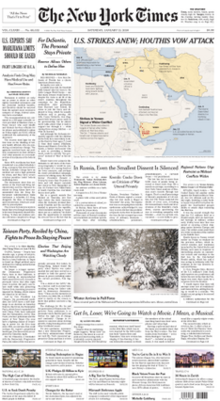Some Of News Articles
Some Of News Articles
Blog Article
The 2-Minute Rule for News Articles
Table of ContentsSome Of News Articles9 Easy Facts About News Articles ShownRumored Buzz on News ArticlesNews Articles - Questions10 Easy Facts About News Articles Explained
Excellent understanding of different subjects offers students an one-upmanship over their peers. Even though digital and social media are readily obtainable, we should not neglect exactly how important it is to read the papers. Moms and dads must try and instill the practice of reviewing a newspaper as a daily regimen to proceed the tradition of the adored print medium.Information tales additionally consist of at least one of the complying with crucial features relative to the designated audience: distance, prestige, timeliness, human passion, curiosity, or repercussion.
Within these restrictions, information stories additionally aim to be extensive. Various other factors are involved, some stylistic and some derived from the media form. Among the larger and a lot more respected papers, justness and equilibrium is a major aspect in providing information. Commentary is usually restricted to a different section, though each paper may have a different general angle.
Papers with a worldwide audience, for instance, have a tendency to use a more official style of composing. News Articles.; common design guides consist of the and the US News Design Book.
The 3-Minute Rule for News Articles
As a rule, journalists will not make use of a lengthy word when a brief one will certainly do. News writers try to avoid using the same word more than as soon as in a paragraph (in some cases called an "echo" or "word mirror").
Headlines occasionally leave out the topic (e.g., "Leaps From Boat, Catches in Wheel") or verb (e.g., "Feline lady lucky"). A subhead (additionally subhed, sub-headline, subheading, caption, deck or dek) can be either a subservient title under the major headline, or the heading of a subsection of the article. It is a heading that precedes the major text, or a group of paragraphs of the major message.

of an article subject, informant, or interviewee), it is referred to as a pulled quotation or pull quote. Extra signboards of any one of these types may appear later in the short article (particularly on subsequent web pages) to entice further reading. Journalistic web sites sometimes use animation methods to switch one billboard for another (e.g.
All about News Articles
Such signboards are likewise utilized as tips to the short article in other sections of the magazine or website, or as ads for the piece in other magazine or sites. News release of the Swiss federal government. Normal framework with title, lead paragraph (recap in strong), other paragraphs (details) and get in touch with information.

Example of a hard-lead paragraph NASA is proposing another room task. The budget plan requests approximately $10 billion for the task.
An "off-lead" is the 2nd most essential front web page news of the day. To "bury the lead" is to start the post with background info or information of additional relevance to the visitors, compeling them to read even more deeply right into a short article than they should have to in order to find the important points.
The Greatest Guide To News Articles
Usual usage is that or 2 sentences each create their very own paragraph. Reporters typically explain the organization use this link or framework of a newspaper article as an upside down pyramid. The essential and most fascinating components of a tale are placed at the start, with sustaining details following in order of decreasing value.
It permits individuals to check out a subject to just the deepness that their interest takes them, and without the charge about his of information or nuances that they could take into consideration unnecessary, yet still making that information available to a lot more interested visitors. The inverted pyramid structure also enables write-ups to be trimmed to any kind of approximate size throughout format, to fit in the area offered.
Some writers start their tales with the "1-2-3 lead", yet there are lots of sort of lead readily available. This style invariably starts with a "Five Ws" opening up paragraph (as explained over), followed by an indirect quote that serves to support a significant aspect of the first paragraph, and then a direct quote to sustain the indirect quote. [] A twist can refer to several things: The last tale in the information program; a "delighted" story to end the show.
Longer short articles, such as magazine cover articles and the pieces that lead the inside areas of a newspaper, are referred to as. Attribute stories vary from straight news in several means. Foremost is the absence of a straight-news lead, the majority of the time. Rather than using the essence of a tale up front, attribute writers might attempt to lure visitors in.
Unknown Facts About News Articles
An attribute's first paragraphs typically associate an appealing minute or occasion, as in an "unscientific lead". From the details of a person or episode, its view swiftly expands to generalities about the tale's topic.

The Editor's Tool kit: A Reference Overview for Beginners and Professionals (2001) Allan M. Siegal and William G. Connolly. The New York City Times Manual of Design and Usage: The Authorities Design Guide Made Use Of by the Writers and Editors of the World's A lot of Authoritative Paper (2002) M. L. Stein, Susan Paterno, and R.
Report this page